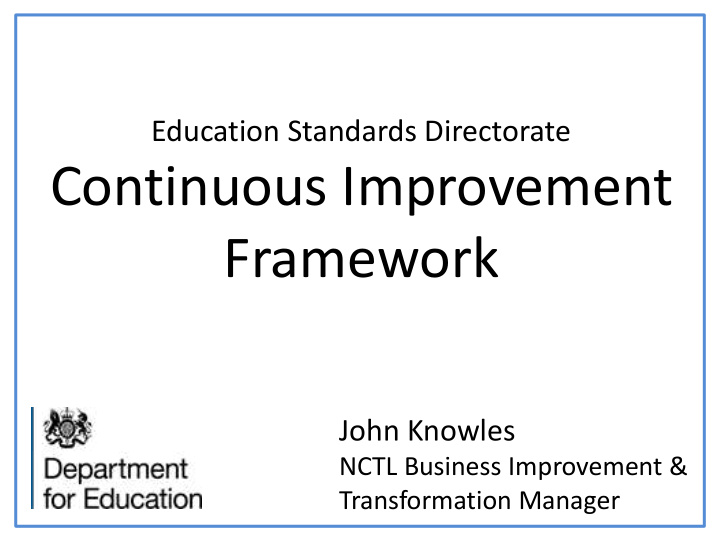



Education Standards Directorate Continuous Improvement Framework John Knowles NCTL Business Improvement & Transformation Manager
Overview Our current improvement framework has evolved over two years, this has been built on strategic business requirements, business expertise, specialist Continuous Improvement knowledge and experiences of working with other public and private sector organisations. The framework has three tiers: 1. Leadership & Culture 2. Building Sustainable Capability 3. Business Improvement & Realising the Benefits The framework is tailored to the business and is underpinned by; learning from and acting upon feedback - adapt not adopt
Leadership & Culture Building a strong network to support our strategic priorities Our senior leaders have endorsed the development of a strong network of business improvement professionals who support each other and share good practice, the network will: • Share expertise , Offering improvement expertise and support to network members and the wider business • Act as a Critical friend , Offering constructive challenge, support and encouragement to network members and the wider business • Undertake Business improvement , Supporting three levels of improvement; Strategic / localised projects and business as usual activity • Report on our improvement activity against the four hallmarks of improvement • Develop an Improvement Showcase , an intranet SharePoint page to share summaries of improvement activity; evidenced with robust data, estimated data and anecdotal information • Build capability , Including; CI ‘NVQ’ style training, consultancy, PPM and facilitation et al
Building Sustainable Capability CI Core Skills Level 5 = can train/coach We have developed an NVQ style CI others Practitioner Practitioner ‘coach’ Level 4 = can do without capability model that delivers core skill support Champion core skill levels business benefits through Level 3 = can do with core skill levels levels (builds on support (builds on structured learning that is based on Champion) Level 2 = Had awareness Practitioner) training the 70:20:10 learning approach: Level 1 = Not aware • A two/three day classroom training CI Project Scoping 3 4 5 course provides awareness of CI Structured Problem 4 5 - Solving core skills (10% classroom learning) Principles of good 4 4 5 • 1:2:1 coaching and other support is process design given to trainee’s as they consolidate RAPID & RACI - 4 5 Runners, Repeaters and their learning (20% social learning) - 4 5 Strangers (RRS) • A structured consolidation Contingency analysis & - 4 5 programme offers the opportunity to mistake proofing Demand and Value - 4 5 realise benefits from a Process Mapping 4 5 - commissioned project or within a Customer Understanding 4 5 - trainee’s day job (70% experiential Feedback Loops - 4 5 learning) Measures and Data 4 5 - Skills are assessed throughout Benefits Realisation 3 5 - Statistical Process Control - 4 5 consolidation by a linked CI coach who Visual Management - 4 5 considers verbal and physical Personal Effectiveness - 4 5 evidence against a set of CI capability After Activity Review 4 5 - requirements. Ability to deliver CI - 4 5 awareness training
Building Sustainable Capability
Business Improvement & Benefits Reduced staff cost Principles of good improvement Reducing cost allows Reduced IT costs Cost us deliver better Reduced estate costs Being able to articulate (Cashable) Reduced travel costs value for money for Hallmark the problem or Reduced consumable the taxpayer costs 1 improvement and how it was identified Efficient processes Reduced waste allow us to reduce Process Increased productivity the cost of our Knowing, and fixing, (Efficiency) Improved quality Hallmark service, whilst Improved performance the root cause of the improving quality 2 problem Could have a direct Increased employee impact on Being able to Organisation engagement productivity and the & People Increased capability Hallmark demonstrate, with data, experience of ours Increased knowledge 3 the impact of the customers improvements Could reduce Reduced queries preventable Increased satisfaction Sharing the learning demand, increasing Customer Reduced complaints Hallmark with other parts of the Reduced customer productivity and 4 waiting Directorate and DfE quality
After Activity Review (Lessons learned) What What did What can Why were actually we set out we learn there happened to do? differences? from this? ? Revisit and review the Concentrate on the facts Compare what you set out Seek to generate a list of objectives and of what actually happened to do with what actually learning points; ask: deliverables and ask: and ask: happened and ask: • How can we build on the • What did we set out to • What did we really • Why were there things that went well? do? achieve? differences? • What are the critical • What were our • Did we get what we • Applaud and articulate lessons we should objectives? wanted? the success capture and not forget? • What were our • Did the customer get • Identify and explore any • Consider what useful milestones? what they wanted? areas that didn’t hit the things might be shared • What were our KPIs/ • Were deadlines met? mark with peers and colleagues measures? • Were measures • Be clear on the next achieved (satisfaction, This process should steps performance)? strengthen the team, not • Did everybody have a divide it, so facilitation is vital clear and common understanding of the objectives and their part in achieving them?
Questions ? ? ? ? ?
Recommend
More recommend